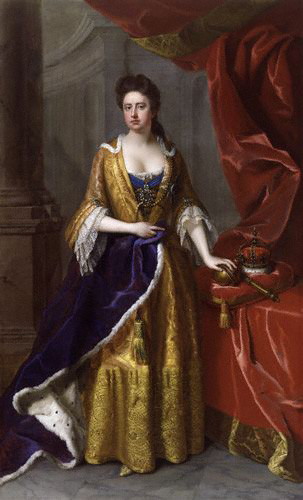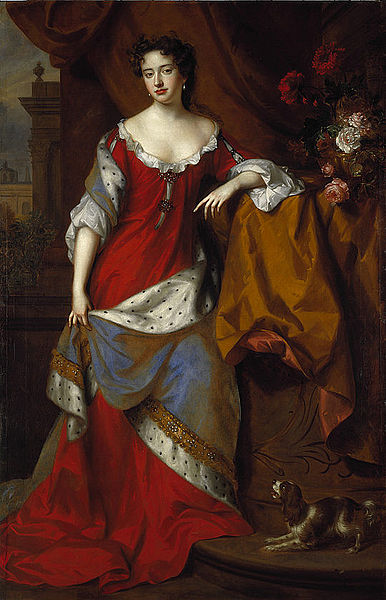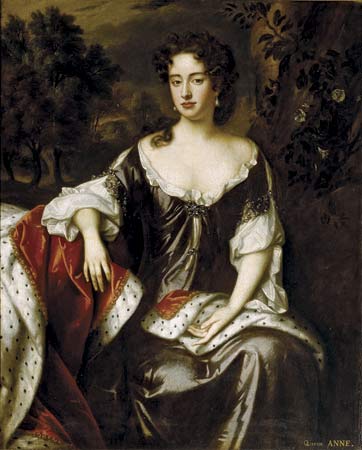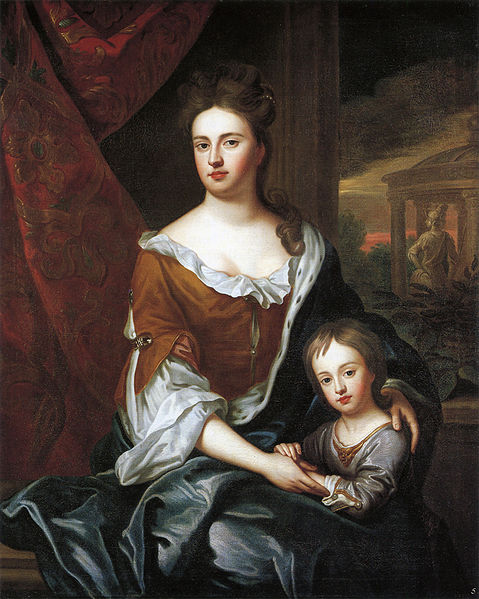<Back to Index>
- Anatomist and Surgeon Pierre-Joseph Desault, 1738
- Writer and Poet Niccolò Ugo Foscolo, 1778
- Queen of England Anne, 1665

Anne (6 February 1665 – 1 August 1714) became Queen of England, Scotland and Ireland on 8 March 1702, succeeding her brother-in-law, William III of England and II of Scotland. Her Catholic father, James II and VII, was deemed by the English Parliament to have abdicated when he was forced to retreat to France during the Glorious Revolution of 1688/9; her brother-in-law and her sister then became joint monarchs as William III & II and Mary II,
the only such case in British history. After Mary's death in 1694,
William continued as sole monarch until his own death in 1702. On 1 May
1707, under the Acts of Union 1707, England and Scotland were united as a single sovereign state, the Kingdom of Great Britain. Anne became its first sovereign, while continuing to hold the separate crown of Queen of Ireland and the title of Queen of France.
Anne reigned for twelve years until her death in August 1714. Anne was
therefore the last Queen of England and the last Queen of Scots.
Anne's life was marked by many crises, both personally and relating to
succession of the Crown and religious polarisation. Because she died
without surviving issue, Anne was the last monarch of the House of Stuart. She was succeeded by her second cousin, George I, of the House of Hanover, who was a descendant of the Stuarts through his maternal grandmother, Elizabeth, daughter of James VI & I. Anne was born at St. James's Palace, London, the second daughter of James, Duke of York (afterwards James II), and his first wife, Lady Anne Hyde. Her paternal uncle was King Charles II and her older sister was the future Queen Mary II. Anne and Mary were the only children of the Duke and Duchess of York to survive into adulthood. As a child, Anne suffered from an eye infection; for medical treatment, she was sent to France. She lived with her grandmother, Henrietta Maria of France who resided in Paris at the Château de Colombes which Henrietta Maria had bought in 1650; Anne later lived with her aunt, Henriette Anne, Duchess of Orléans, following her grandmother's death in 1669. She grew up with her cousins Marie Louise d'Orléans and Anne Marie d'Orléans, future maternal grand mother of Louis XV. Anne returned to England in 1670, at the death of her aunt Henriette Anne. In about 1673, Anne made the acquaintance of Sarah Jennings, who became her close friend and one of her most influential advisors. Jennings later married John Churchill (the future Duke of Marlborough), who was to become Anne's most important general. In 1673, Anne's father's conversion to Roman Catholicism became public. On the instructions of Charles II, however, Anne and her sister Mary were raised as Protestants. On 28 July 1683, Anne married the Protestant Prince George of Denmark-Norway, brother of King Christian V of Denmark-Norway, an unpopular union but one of great domestic happiness. Sarah Churchill became Anne's Lady of the Bedchamber,
and, by Anne's desire to mark their mutual intimacy and affection, all
deference due to her rank was abandoned and the two ladies called each
other Mrs. Morley and Mrs. Freeman. When
Charles II died in 1685, Anne's father became king as James II. But
James was not well received by the English people, concerned about his Catholicism. Public alarm increased when James's second wife, Mary of Modena, gave birth to a son (James Francis Edward) on 10 June 1688, and a Catholic dynasty became all the more likely. Anne was not present on the occasion, having gone to Bath,
and this gave rise to a belief that the child was spurious; but it is
most probable that James's desire to exclude all Protestants from
affairs of state was the real cause. Princess Anne's brother-in-law and sister, William and Mary, subsequently invaded England to dethrone the unpopular James II in the Glorious Revolution. Forbidden
by James to pay Mary a projected visit in the spring of 1688, Anne
corresponded with her and was no doubt aware of William's plans to
invade. On the advice of the Churchills—Anne's conduct during this
period was probably influenced a great deal by them—she
refused to show any sympathy for James after William landed in November
and wrote instead to William, declaring her approval of his action.
Churchill abandoned the king on the 24th of that month, Prince George
on the 25th, and when James returned to London on the 26th, he found
that Anne and her lady-in-waiting had done likewise the previous night. He
put the women under house arrest in the Palace of Whitehall. However,
escaping from Whitehall by a back staircase they put themselves under
the care of the bishop of London, spent one night in his house, and
subsequently arrived on the 1st of December at Nottingham, where the
princess first made herself known and appointed a council. Thence she
travelled to Oxford, where she met Prince George, in triumph, escorted
by a large company. She returned to London on 19 December, where she
was at once visited by her brother-in-law William. In 1689, a Convention Parliament assembled
and declared that James had abdicated the realm when he attempted to
flee, and that the Throne was therefore vacant. The Crown was offered
to Mary, but accepted jointly by William and Mary, who thereafter ruled as the only joint monarchs in British history. The Bill of Rights 1689 settled
succession to the Throne; Princess Anne and her descendants were to be
in the line of succession after William and Mary. They were to be
followed by any descendants of William by a future marriage.
Soon after their accession, William and Mary rewarded Churchill by
granting him the Earldom of Marlborough. Their subsequent treatment of
the Marlboroughs, however, was not as favourable. In 1692, suspecting
that Lord Marlborough was a Jacobite,
Mary dismissed him from all his offices. Lady Marlborough was
subsequently removed from the Royal Household, leading Princess Anne to
angrily leave her royal residence for Syon House,
the Duke of Northumberland's home. Princess Anne was then stripped of
her guard of honour, and the guards at the royal palaces were forbidden
to salute her husband. When Mary II died of smallpox in 1694, William III continued to reign alone. Anne then became his heir apparent,
since any children he might have by another wife were assigned to a
lower place in the line of succession. Seeking to improve his own
popularity (which had always been much lower than that of his wife), he
restored Princess Anne to her previous honours, allowing her to reside
in St. James's Palace. At the same time William kept her in the background and refrained from appointing her regent during his absence.
In 1695, William sought to win Princess Anne's favour by restoring
Marlborough to all of his offices. In return Anne gave her support to
William's government, though about this time, in 1696 she wrote to her
father asking for his leave to wear the crown at William's death, and
promising its restoration at a convenient opportunity. The
unfounded rumour that William contemplated settling the succession
after his death on James's son, provided he were educated a Protestant
in England, may possibly have alarmed her. During
this period, Prince George and Princess Anne suffered great personal
misfortune. By 1700, the future Queen had been pregnant at least
eighteen times; thirteen times, she miscarried or gave birth to
stillborn children. Based on her foetal losses and physical symptoms, a
medical historian has diagnosed disseminated lupus erythematosus. Of the remaining five children, four died before reaching the age of two years. Her only son to survive infancy, William, Duke of Gloucester, died at the age of eleven on 29 July 1700, precipitating a succession crisis. William and Mary had not had any children; thus, Princess Anne, the heir apparent to the Throne, was the only individual remaining in the line of succession established by the Bill of Rights 1689. If the line of succession were totally extinguished, then it would have been open for the deposed King James or his son James Francis Edward Stuart (the "Old Pretender") to claim the Throne. Thus, to preclude a Catholic from obtaining the Crown, Parliament enacted the Act of Settlement 1701, which provided that, failing the issue of Princess Anne and of William III by any future marriage, the Crown would go to Sophia, Electress of Hanover, and her descendants, who descended from James I of England through Elizabeth Stuart.
Several genealogically senior claimants were disregarded due to their
Catholicism. Anne acquiesced to the new line of succession created by
the Act of Settlement. Almost as soon as she succeeded to the throne, Anne became embroiled in the War of the Spanish Succession. This war, in which England supported the claim of Archduke Charles to
succeed to the Spanish Throne, would continue until the last years of
Anne's reign, and would dominate both foreign and domestic policy. Soon after her accession, Anne appointed her husband Lord High Admiral, giving him control of the Royal Navy. Anne gave control of the army to Lord Marlborough, whom she appointed Captain-General. Marlborough also received numerous honours from the Queen; he was created a Knight of the Garter and was elevated to the ducal rank. The Duchess of Marlborough was appointed to the post of Mistress of the Robes, the highest office a lady could attain. In passing the Act of Settlement, in 1701, the English Parliament had neglected to consult with the Parliament of Scotland or Estates of Scotland, which, in part, wished to preserve the Stuart dynasty and its right of inheritance to the Throne. The Scottish response to the Settlement was to pass the Act of Security;
a bill which stated that — failing the issue of the Queen — the Estates
had the power to choose the next Scottish monarch from amongst the
numerous descendants of the royal line of Scotland. Though it was
originally not forthcoming, Royal Assent to
the act was granted when the Scottish Parliament threatened to withdraw
Scottish troops from the Duke of Marlborough's army in Europe and
refused to impose taxes. In its turn, the English Parliament — fearing that an independent Scotland would restore the Auld Alliance (with France) — responded with the Alien Act 1705, which provided that economic sanctions would be imposed and Scottish subjects would be declared aliens (putting
their right to own property in England into jeopardy), unless Scotland
either repealed the Act of Security or moved to unite with England.
Eventually the Estates chose the latter option, and Commissioners were
appointed by the Queen Anne to negotiate the terms of a union between
the two countries. Articles of Union were approved by the Commissioners
on 22 July 1706, agreed to by an Act of the Scottish Parliament passed
on 16 January 1707 and an act of the English Parliament passed on 6
March 1707. Under the Acts, England and Scotland became one realm, a united kingdom called Great Britain, on 1 May 1707. Anne's
reign was further marked by the development of a two-party system as
the new era of parliamentary governance unfolded and matured. Anne
personally preferred the Tory Party, but "endured" the Whigs. Because of Anne's personal preferences, her first ministry was primarily Tory; at its head were Sidney Godolphin, 1st Baron Godolphin and Anne's favorite John Churchill, 1st Duke of Marlborough, both moderate Tories, but it also contained such high Tories as Daniel Finch, 2nd Earl of Nottingham and Anne's uncle Laurence Hyde, 1st Earl of Rochester. Marlborough and Godolphin kept up connections to the Whigs through the Speaker of the House of Commons, Robert Harley.
But the Whigs, who unlike the Tories were vigorous supporters of the
War of the Spanish Succession, became much more influential after the
Duke of Marlborough won a great victory at the Battle of Blenheim in
1704. Most of the High Tories, who had opposed British involvement in
the land war against France, were gradually removed from office, and
Godolphin, Marlborough, and Harley, by now a Secretary of State, who formed the ruling "triumvirate", were forced to rely more and more on support from the Whigs, and particularly from the Junto Whigs whom Queen Anne particularly disliked. In 1706, Godolphin and Marlborough forced Anne to accept Lord Sunderland,
a Junto Whig and Marlborough's son-in-law, as Harley's colleague as
Secretary of State. Although this strengthened the ministry's position
in parliament, it weakened the ministry's position with the Queen, as
Anne became increasingly irritated with Godolphin and with her
erstwhile favorite, the Duchess of Marlborough. Increasingly, the Queen
turned for private advice to Harley, who was increasingly uncomfortable
with Marlborough and Godolphin's turn towards the Whigs, and was moving
closer to supporting the Tory "blue water" policy on the war; and to Abigail Hill,
a cousin of the Duchess who became more amenable to Anne as her
relationship with Sarah deteriorated. The division within the ministry
came to a head in February 1708, when Godolphin and Marlborough
insisted that the Queen must either dismiss Harley or do without their
services. When the Queen seemed to hesitate, Marlborough and Godolphin
refused to attend a cabinet meeting on 8 February. When Harley
attempted to lead business without his erstwhile colleagues, several of
those present, including the Duke of Somerset refused to participate until Godolphin and Marlborough returned.
Her hand forced, the Queen dismissed Harley on 11 February. But
Godolphin and Marlborough's victory was a hollow one, as their personal
relationship with Anne would never recover from the blow. Furthermore,
they found themselves increasingly at the mercy of the Junto leaders.
Whereas previously they had been able to determine war policy largely
as they liked, their total parliamentary dependence on the Whigs meant
that they had to consult with Junto leaders Lord Somers and Lord Halifax. This dependence on the hated Junto only increased the Queen's dislike of the ministry. Anne's husband, Prince George of Denmark, died in October 1708. His leadership of the Admiralty was
unpopular amongst the Whig leaders; as he lay on his deathbed, some
Whigs were preparing to make a motion requesting his removal from the
office of Lord High Admiral. Anne was forced to appeal to the Duke of
Marlborough to ensure that the motion was not made. Anne was devastated
by the loss of her husband, and the event proved a turning point in her
relationship with her old friend, Sarah Churchill, Duchess of Marlborough. The Duchess arrived at Windsor shortly
after he died, and forced the Queen to leave the castle and move to St.
James's Palace against her will. Anne pleaded to be left alone, and
resented the Duchess for insisting that the grieving Queen be attended
at all times. The
Whigs used the Prince's death to their own advantage. With Whigs now
dominant in parliament, and Anne overbowed by the loss of her husband,
they forced her to accept the Junto leaders Lord Somers and Lord Wharton into the cabinet. Their power was, however, limited by Anne's insistence on carrying out the duties of Lord High Admiral herself,
and not appointing a member of the government to take Prince George's
place. Undeterred, the Junto demanded the appointment of the Earl of Orford, another member of the Junto and one of Prince George's leading critics, as First Lord of the Admiralty. Anne flatly refused, and chose her own candidate, the moderate Tory Thomas Herbert, 8th Earl of Pembroke on 29 November 1708.
Pressure mounted on Pembroke, Godolphin and the Queen from the
dissatisfied Junto Whigs, and Pembroke was forced to resign after less
than a year in office. Another month of arguments followed before the
Queen finally consented to put the Admiralty in control of the Earl of Orford in November 1709. As
the expensive War of the Spanish Succession grew unpopular so too did
the Whig administration. Harley, now in opposition, was particularly
skillful in using the issue (of the cost of the war) to motivate the
electorate. The Queen, increasingly disdained by her ministry's policy
of "no peace without Spain", finally took the opportunity to dismiss
Godolphin in August 1710. The Junto Whigs (Sunderland, Somers, Wharton,
and Orford) were also removed from office, although Marlborough, for
the moment, remained as commander of the army. In their place, she
appointed a new ministry, headed by Harley, which began to seek peace
with France. Harley and the Tories were ready to compromise by giving
Spain to the grandson of the French King, but the Whigs could not bear
to see a Bourbon on the Spanish Throne. In the parliamentary elections which soon followed, Harley used government patronage to create a large Tory majority.
The dispute was resolved by outside events: the elder brother of
Archduke Charles (whom the Whigs supported) died in 1711 and Charles
then inherited Austria, Hungary and the throne of the Holy Roman Empire. To give him also the Spanish throne to which he had aspired was no longer in Great Britain's interests. But the proposed Treaty of Utrecht submitted to Parliament for ratification did not go as far as the Whigs wanted to curb Bourbon ambitions. In the House of Commons, the Tory majority was unassailable, but the same was not true in the House of Lords.
Seeing a need for decisive action — to erase the Whig majority in the
House of Lords — Anne created twelve new peers. Such a mass creation of
peers was unprecedented; indeed, Elizabeth I had granted fewer peerage dignities in forty-four years than Anne did in a single day. This allowed for ratification of the Treaty and thus ended Great Britain's involvement in the War of the Spanish Succession. Anne died of suppressed gout, ending in erysipelas, on 1 August 1714. Her body was so swollen and large that it had to be buried in Westminster Abbey in a vast almost-square coffin. Anne died shortly after the Electress Sophia (8 June, the same year); the Electress's son, George I, Elector of Hanover, inherited the British Crown. Pursuant to the Act of Settlement 1701,
the crown was settled on George as Electress Sophia's heir, with the
possible Catholic claimants, including James Francis Edward Stuart,
ignored. However, the Elector of Hanover's accession was relatively
stable: Jacobite risings in 1715 and 1719 both failed.


